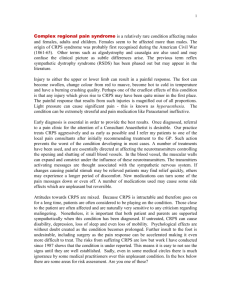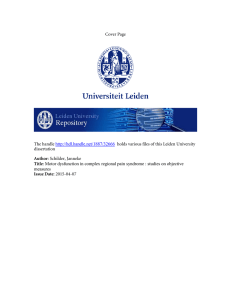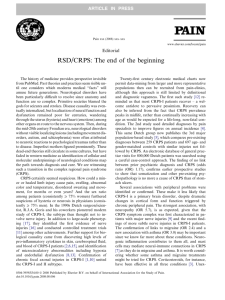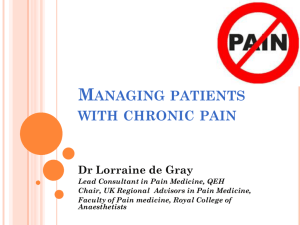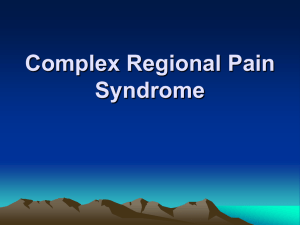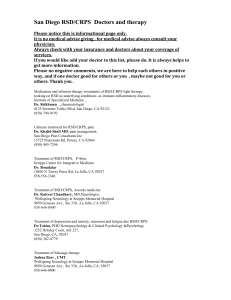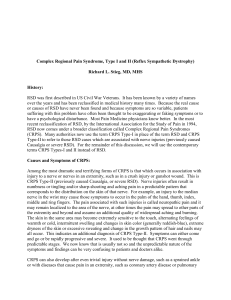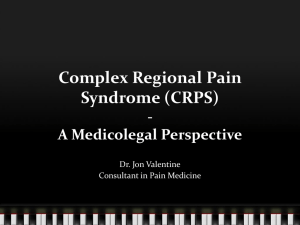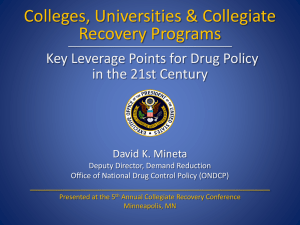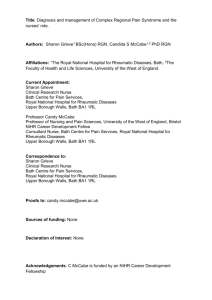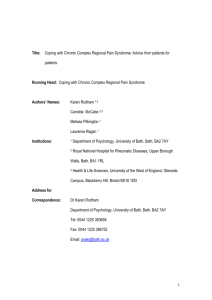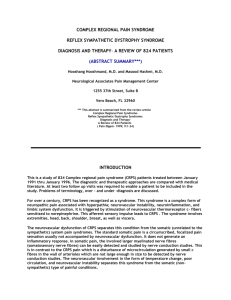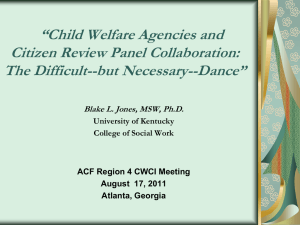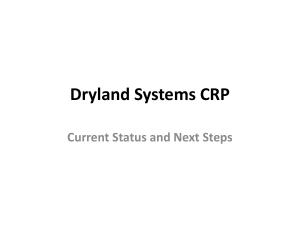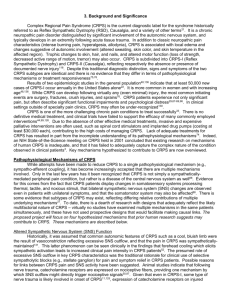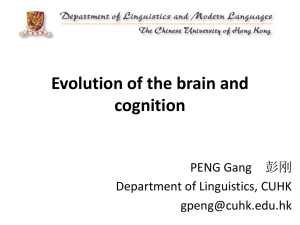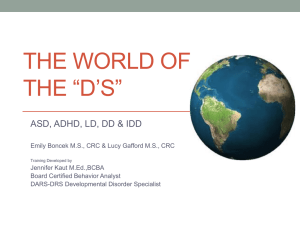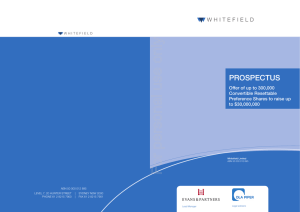PowerPoint
advertisement
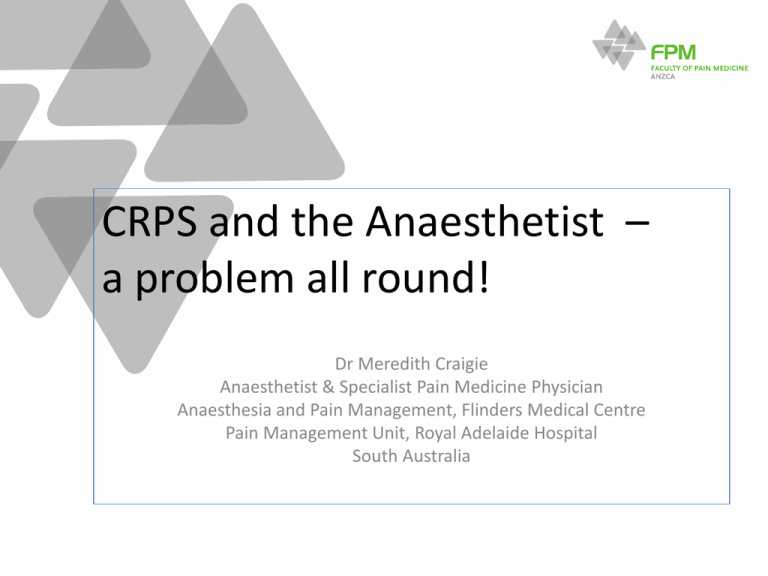
CRPS and the Anaesthetist – a problem all round! Dr Meredith Craigie Anaesthetist & Specialist Pain Medicine Physician Anaesthesia and Pain Management, Flinders Medical Centre Pain Management Unit, Royal Adelaide Hospital South Australia Conflict of Interest • Employed at FMC, RAH, Adelaide, South Australia • Private practice at Pelvic Pain SA • Affiliated with Faculty of Pain Medicine, ANZCA and Australian and New Zealand College of Anaesthetists Outline of the problems • What causes CRPS? • What are the diagnostic criteria for CRPS in children? • Psychological factors in CRPS – cause or effect? • How can we manage CRPS in children? • What is the role of the Anaesthetist? • Prognosis for children with CRPS? An Australian story of CRPS 3 months later…… Pathophysiology of CRPS • Persistent inflammatory activity • Pathological vasospasm • fMRI changes – the “CRPS brain” • Visual distortion and changes in somatosensory cortex S1 • QST changes • Small fibre neuropathy Parkitny et al (2013) Neurology 80:106-117 Moseley, Pearson, Spence (2008) Curr Biol 18:R1048 Pistorius et al (2013) Angiology 59:301-5 Maihofner et al (2003) Neurology 61:1707-15 Lebel et al (2008) Brain 131:1854-79 Sethna et al (2007) Pain 131:153-61 Budapest criteria for CRPS • Continuing pain disproportionate to the inciting event • Symptoms- at least 1 symptom in 4 categories – Sensory • hyperaesthesia – Vasomotor • temp asymmetry; colour changes and/or skin colour asymmetry – Sudomotor/oedema • oedema; sweating changes and/or sweating asymmetry – Motor/tropic • decreased ROM; motor dysfunction; hair, nail or skin changes Harden, Bruehl et al (2010) Pain 150:268-74 Budapest criteria for CRPS • Signs: evidence of at least 1 sign in 2 or more categories – Sensory • hyperalgesia (pin prick) and/or allodynia (light touch) – Vasomotor • temp asymmetry; colour changes and/or skin colour asymmetry – Sudomotor • oedema; sweating changes and/or swearing asymmetry – Motor/tropic • decreased ROM; motor dysfunction; hair, nail or skin changes Harden, Bruehl et al (2010) Pain 150:268-74 CRPS presentations • Epidemiology – Females : males 5-13:1 – Lower limb : upper limb – Peak age 5-16:1 12-14 years • Triggers – Minor trauma to major surgery – Immunisation – None identified Murray et al (2000) Arch Dis Child 82:231-33 Wolter, Knoller, Rommel (2012) Eur Neurol 68:52-58 Pearson, Bailey (2011) Military Medicine 176:876-8 Richards et al (2012) Arch Dis Child 97:913-5 1 week later….. • Hospital management – Bed rest/bed cradle – Morphine PCA – No progress after 1 wk • See PMU consultant – – – – Get rid of PCA/opioids See physiotherapist See psychologist Return to psychiatrist Psychological issues • Somatisation 60% • Mood disorders 29% – Anxiety 47% – Depression 27% • Peer/school problems 27/13% – Social isolation • Cognitive function generally intact – Impaired memory/working composite memory Ciccone, Bandilla, Wu (1997) Pain 71:323-33 Cruz, O’Reilly et al (2011) Clin J Pain 27:27-34 Families • • • • Genetic basis in some families Family problems 40% Impact on family members Economic impact • 40% CRPS I • 2/3 not in full-time school • 68% parents took time off work • UK: direct and indirect costs ~ £ 8,000/yr extrapolates to £ 3,840 million /yr Shirani et al (2010) Can J Neurol Sci 37:389-94 Pearson, Bailey (2011) Military Medicine 176:876-8 Sleed et al (2005) Pain 119:185-90 Treatment options • Based on biopsychosocial model – Multidisciplinary approach • Physiotherapy • Psychology – Individual and family therapy +/- psychiatry • Medication – Blocks • Other novel treatments What affects Rx choices for children? • Beliefs concerning causes of pain • Knowledge and preferences for pain Rx • Expectations of outcome of pain Rx • Reduction in pain required for patient to resume ‘reasonable activities’ • Typical coping response for stress or pain • Family expectations & beliefs Physiotherapy key to recovery • Goal: functional restoration • • • • Desensitisation Hydrotherapy Land exercises Mirror box therapy • • Lee et al (2002) 141:135-40 Logan et al (2012) Clin J Pain 28:766-74 Wilder (2006) Clin J Pain 22:443-8 Role of the Anaesthetist in CRPS • Interventionist only? • Clinical team leader • Requirements: – Understand pathophysiological aetiologies – Understand key management principles – Understand role of medication in managing CRPS – Understand evidence for regional blockade and other invasive techniques Acute noci mild Paracetamol NSAIDs Codeine +++ ++ ++ Tramadol Morphine Amitriptyline Anticonvulsants - Acute noci Acute Chronic severe neuropathic non-cancer ++ ++ + ++ +++ - Wheeler, Vaux, Tam (2000) Ped Neurol 22:220-1 + + + + ++ ++ ++ ++ ++ ++ + Regional blockade • IV regional blockade – Guanethidine – Lignocaine – Ketorolac • Catheter techniques – Major nerve plexus – Epidural – Intrathecal Kaplan, Claudio, Kepes, Gu (1996) 40:1216-22 Suresh, Wheeler, Patel (2003) Anesth Analg 96:694-5 Cepeda, Carr, Lau (2005) Cochrane Database of Systematic Review CD004598 Dadure et al (2005) Anesth 102:387-91 Other invasive treatments • Intravenous lignocaine infusion • Spinal cord stimulation • Novel treatments – IV pamidronate – IV Iloprost (prostaglandin analog) – Intrathecal ziconamide Wallace et al (2000) Anesthesiol 92:75-83 Petje et al (2005) Clin Ortho & Rel Res433:178-82 Stanton-Hicks, Kapural (2006) J Pain Sympt Manage 32:509-11 Olssen, Meyerson, Linderoth (2008) Eur J Pain 12:53-9 Simm, Briody et al (2010) 46:885-88 Role of psychologist • Assessment of child • Based on CBT, ACT – Challenge thoughts • Biobehavioural techniques – Breathing techniques – Meditation – Self-hypnosis • Facilitate physical therapy Psychiatrist • Controversial area – At risk of anxiety or depression 67% – At risk of anxiety, depression and somatisation 47% • Family therapy • Medication if necessary Cruz et al (2011) Clin J Pain 27:27-34 Progressing recovery Child taking charge of own management – Willingness to self-manage pain – Active coping strategies • Support team • Return to school Logan et al (2012) 153:1863-70 Prognosis • Overall outcomes better in children – Highly variable recovery time • Morbidity • Relapse rates high - 50%-79% – 10% symptoms persist > 1yr • Future treatment options – Immunomodulatory agents Sherry et al (1999) Clin j Pain 15:218-22 Lee et al (2002) J Pediatr 141:135-40 Murray et al (2000) Arch Dis Child 82:231-33 Logan et al (2012) Clin J Pain 28:766-74 Resources My Pain Toolkit www.paintoolkit.org “Good practice in postoperative and procedural pain” -APAGBI www.apagbi.org.uk/docs/APA_Guidelines_on_Pain _ Management.pdf Acute Pain Management: Scientific Evidence 3rd Ed. ANZCA and FPM www.anzca.edu.au/resources/ Book “Pain Pain Go Away Helping Children with Pain” download at www.rch.org.au Summary • Outlined potential causes CRPS • Diagnostic criteria for CRPS in children • Psychological factors in CRPS • Management options for CRPS in children • The role of the Anaesthetist • Relatively good prognosis for children with CRPS Thank you • • • • • • • • THE TEAM Dr Bruce Foster, Orthopaedic surgeon Dr Penny Briscoe, Pain Medicine Physician Ms Helen Burgan, Physiotherapist Ms Lindy Peterson, Clinical Psychologist Dr John Govan, Psychiatrist Pembroke School Catherine’s family and friends
